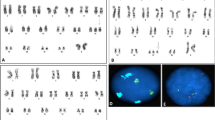Summary
The authors report a case of triploidy in a prematurely born child. The pregnancy was complicated by severe toxemia beginning during the second trimester and terminating in preeclampsia leading to cesarian section in the 33th week of gestation. The externally female child was underweight, hypotonic and asphyctic and died shortly after birth. She exhibited a complex brain malformation including excessive hydrocephaly, cebocephaly and aplasia of the piturary gland, and multiple dysmorphic signs. Autopsy revealed hypoplasia and dysplasia of the adrenal glands; no uterus, tubes and ovaries were present, but no testes were found. The placenta showed localized hydatidiform degeneration and was relatively large. The karyotype was 69,XXY, and with the aid of fluorescence markers, paternal origin of the additional haploid chromosome set was demonstrated. Typical findings in pregnancies with fetal triploidy are discussed and the possibility of prenatal diagnosis of triploidy by chromosome analysis in cultivated amniotic fluid cells is pointed out.
Zusammenfassung
Ein Fall von kindlicher Triploidie wird vorgestellt. Die Schwangerschaft war gekennzeichnet durch therapieresistente EPH-Gestose im 2. Trimenon mit Übergang in Präeklampsie in der 33. Woche. Der durch Sectio entbundene, nicht lebensfähige Fetus war äußerlich weiblich, untergewichtig, hypoton und asphyktisch. Er wies eine Hirnmißbildung mit Kebozephalie, einem großen univentrikulären Hohlraum und Fehlen der Hypophyse sowie multiple Mißbildungen und dysmorphe Zeichen auf. Bei der Sektion fanden sich Hypo- und Dysplasie der Nebennieren; Uterus, Tuben und Ovarien waren nicht angelegt, Testes waren nicht nachweisbar. Die Plazenta war auffallend groß und zeigte herdförmige hydatidiforme Degenerationen der Zotten. Der Karyotyp war 69,XXY, und mit Hilfe der Fluoreszenzmarker ließ sich der väterliche Ursprung des überzähligen haploiden Satzes nachweisen. Die für Triploidie typischen Schwangerschaftsbefunde werden besprochen und auf die Möglichkeit der pränatalen Diagnose durch Chromosomenuntersuchung an gezüchteten Zellen der Amnionflüssigkeit wird hingewiesen.
Similar content being viewed by others
Literatur
Atkins, L., Böök, J. A., Santesson, B.: Chromosome DNA synthesis in the cells of a human triploid/diploid mosaic. Hereditas55, 55–67 (1966)
Beischer, N. A., Fortune, D. W., Fitzgerald, M. G.: Hydatidiforme mole and coexistent foetus, both with triploid chromosome constitution. Brit. med. J.3, 476–478 (1967)
Boué, J.-G., Boué, A.: Les aberrations chromosomiques dans les avortements spontanés humains. Presse Méd.78, 635–641 (1970)
Boué, J., Boué, A.: Les avortements spontanés humains. Etudes cytogénétiques et épidémiologiques. Rev. franç. Gynéc.68, 625–643 (1973)
Carr, D. H.: Chromosome studies in selected spontaneous abortions: polyploidy in man. J. med. Genet.8, 164–174 (1971)
Caspersson, T., Zech, L., Johansson, C.: Analysis of the human metaphose chromosome set by aid of DNA-binding fluorescent agents. Exptl. Cell Res.62, 490–492 (1970)
Edwards, J. H., Yuncken, C., Rushton, D. I., Richards, S., Mittwoch, U.: Three cases of triploidy in man. Cytogenetics6, 81–104 (1967)
Gruenwald, P., Minh, H. N.: Evaluation of body and organ weights in perinatal pathology. Amer. J. Obstet. Gynec.82, 312–319 (1961)
Hashimoto, J. S., Ling, S. H., Millerick, J. D., Kelley, D. J.: Mid-trimester pre-eclampsia associated with fetal triploidy: Report of a case. Amer. J. Obstet Gynec.116, 882–883 (1973)
Henriksson, P., Hakansson, L., Sandahl, B.: A liveborn triploid infant. Acta Paediat. Scand.63, 447–449 (1974)
Holmes, L. B., Driscoll, S., Atkins, L.: Genetic heterogeneity of cebocephaly. J. med. Genet.11, 35–40 (1974)
Jacobs, P. A., Melville, M., Ratcliffe, S., Keay, A. J., Syme, J.: A cytogenetic survey of 11,680 newborn infants. Ann. Hum. Genet.37, 359–376 (1974)
Keller, P. J., Greub, H., Gerber, C., Schreiner, W. E.: Die Proteohormone der menschlichen Plazenta. I. Radioimmunologische Bestimmung und Bedeutung des plazentaren Laktogens. Schweiz. Z. Gynäk. Geburtsh.1, 149–161 (1970)
Keller, P. J., Gerber, C., Kopper, E.: Die Proteohormone der menschlichen Plazenta. IV. Die HPL-Aktivität im Serum bei Diabetes, Rhesusinkompatibilität, Übertragung, Blasenmole und anderen Schwangerschaftskomplikationen. Schweiz. Z. Gynäk. Geburtsh.3, 31–38 (1972)
Levy, J., Chadeyron, P.-A., Fonty, B.: Avortements spontanés et triploidie. Rev. franç. Gynéc.67, 327–342 (1972)
Niebuhr, E.: Triploidy in man. Cytogenetical and clinical aspects. Humangenetik21, 103–125 (1974)
Paterson, W. G., Hobson, B. M., Smart, G. E., Bain, A. D.: Two cases of hydatidiform degeneration of the placenta with fetal abnormality and triploid chromosome constitution. J. Obstet. Gynec.78, 136–142 (1971)
Prader, A.: Der Genitalbefund beim Pseudohermaphroditismus femininus des kongenitalen adrenogenitalen Syndroms. Morphologie, Häufigkeit, Entwicklung und Vererbung der verschiedenen Genitalformen. Helv. paediat. Acta9, 230–248 (1954)
Prats, J., Sarret, E., Moragas, A., Martin, C.: Triploid live fullterm infant. Helv. paediat. Acta26, 164–172 (1971)
Schindler, A.-M., Mikamo, K.: Triploidy in man. Cytogenetics9, 116–130 (1970)
Schinzel, A., Schmid, W., Lüscher, U., Nater, M., Brook, C., Steinmann, B.: Structural aberrations of chromosome 18. I. The 18p-syndrome. Arch. Genet.47, 1–15 (1974)
Schmid, W., Vischer, D.: A malformed boy with double aneuploidy and diploid/triploid mosaicism 48,XXYY/71,XXXYY. Cytogenetics6, 145–155 (1967)
Seabright, M.: A rapid banding technique for human chromosomes. Lancet II, 971–972 (1971)
Therkelsen, A. J.: Personal communication (1973)
Uchida, I. A., Lin, C. C.: Identification of triploid genome by fluorescence microscopy. Science176, 304–305 (1972)
Walker, S., Andrews, J., Gregson, N. M., Gault, W.: Three further cases of triploidy in man surviving to birth. J. med. Genet.10, 135–141 (1973)
Zergollern, L., Dražancič, A., Damjanov, I., Hitrec, V., Gorečan, V., A liveborn infant with triploidy (69,XXX). Z. Kinderheilk.112, 293–300 (1972)
Author information
Authors and Affiliations
Additional information
Die Autoren danken Herrn Dr. M. Zachmann (Kinderspital Zürich) für seine wertvollen Hinweise auf endokrinologischem Gebiet.
Rights and permissions
About this article
Cite this article
Schinzel, A., Hayashi, K., Schmid, W. et al. Triploidie als Ursache von Schwangerschaftsgestose im 2. Trimenon. Arch. Gynak. 218, 113–123 (1975). https://doi.org/10.1007/BF01395911
Received:
Issue Date:
DOI: https://doi.org/10.1007/BF01395911




